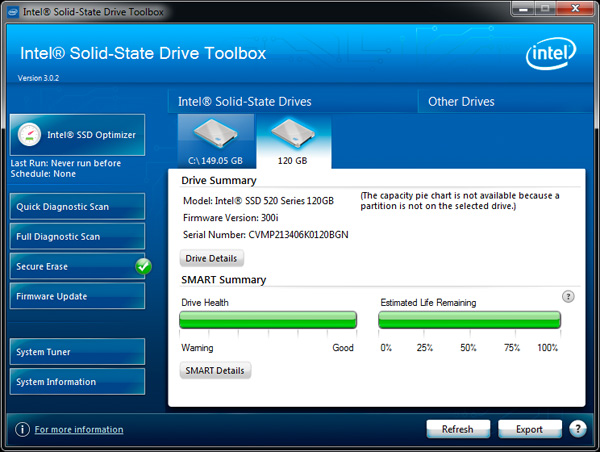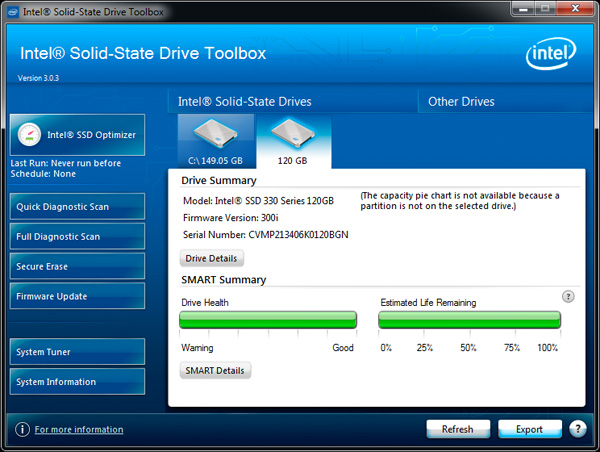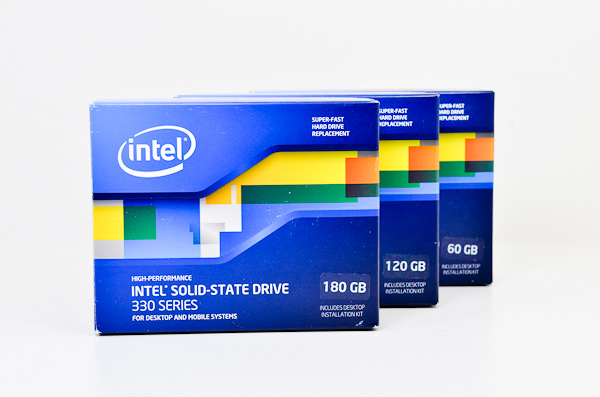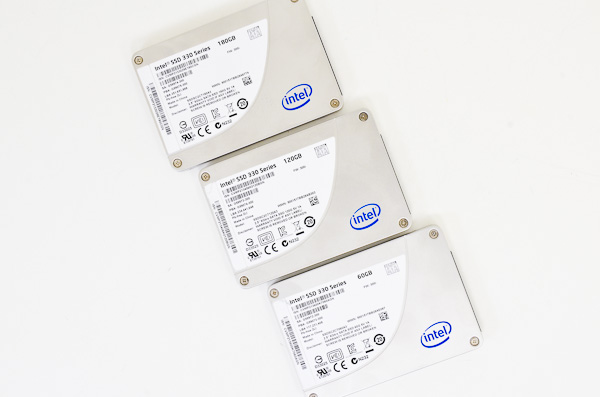The Intel SSD 330 Review (60GB, 120GB, 180GB)
by Anand Lal Shimpi on August 1, 2012 12:01 AM ESTEarlier this year Intel introduced its second SandForce based SSD: the Intel SSD 330. While Intel had previously reserved the 5xx line for 3rd party controllers, the 330 marks the first time Intel has used something other than its own branded controller in a mainstream or 3-series drive.
I don't doubt that I'll eventually get the story of how we got here. Apparently there's a good one behind why Intel's sequential write speed was capped at 100MB/s in the early days of the X25-M's controller. Regardless of how, this is where we are today: every new Intel SSD, with the exception of the high-end PCIe solution, is now powered by SandForce's SF-2281 controller and not Intel's own silicon.
The firmware is of course a collaboration between Intel and SandForce, although it's not clear if Intel ever had access to the firmware's source code or not. The result is a solution that performs a little differently than a standard SandForce drive, but should be less prone to compatibility/stability/reliability issues that have plagued SandForce drives for the past year. The latter is difficult to quantify.
We have seen examples of better behavior from Intel's SF-2281 firmware internally, and even wrote about one in our original Cherryville review. Despite Intel's best efforts, there are starting to be a small percentage of issues being reported in the wild. The number of publicly reported problems is very low, but it's impossible to say if this is a function of time or a truly superior design. I'm still comfortable in saying Intel's SandForce drives are good and likely better tested than any other SF drive, but as with any SSD, there can be issues depending on your system configuration. For what it's worth, even Intel's own controllers have had issues.
The Intel SSD 330
The 330 is available in four capacities: 60GB, 120GB, 180GB and 240GB. The limited launch capacities are a bit odd when you consider the Intel SSD 320 was available from 40GB all the way up to 600GB. Given the 330 uses the same controller as the 520, anyone who needs a larger drive can always buy the 520 instead.
Architecturally the 330 and 520 are identical. They both use the same SF-2281 6Gbps controller, and they both use Intel's 25nm MLC NAND. Actually, if you look at the 330's PCB itself you'll see the same layout as the 520 and Cherryville codename silkscreened onto the board. Despite the latter, Intel's SSD 330 is technically codenamed Maple Crest.
The similarities don't end there either. If you haven't updated to the latest Intel SSD Toolbox, the 330 is actually detected by the software as a 520:

Updating to the latest version rectifies the latter:

The 330 and 520 are very similar drives. The 330's primary differentiation comes from its use of cheaper, lower endurance MLC NAND. I'll get to the math behind why this isn't an issue at all for most users shortly. Conceptually, the 330 vs. the 520 is very similar to Kingston's HyperX 3K vs. regular HyperX drive. Just like with frequency binning for CPUs, there's endurance binning for NAND. Lower endurance parts are more plentiful (and thus cheaper) while the highest endurance parts will be sold for a premium (e.g. MLC-HET). If Intel does its job right, most of the stuff in the middle should be very good. And if it does its job really well, even the lower endurance parts should be more than good enough.
Intel's SSD 330 also carries a different firmware version from the 520: 300i vs. 400i. The firmware changes are likely minor in nature, however one major change is the loss of Intel's E2/E3/E4 SMART attributes for quick endurance testing. As I mentioned in our look at Intel SSDs in the enterprise, you can use these attributes to determine write amplification and estimate NAND longevity of a given workload. Intel views these as enterprise features, and with the 330's focus exclusively as a client drive it loses the features. You still have an accurate count of total host writes vs. NAND writes, as well as Intel's media wear indicator that lets you know what percentage of p/e cycles you have exhausted. I suspect this is more of Intel's famous forced segmentation at work rather than true delineation between client and datacenter drives. Depending on the server and workload, the 330 could be just fine.
Pricing
Using cheaper NAND allows Intel to be a little more aggressive on the 330's pricing without sacrificing margins. We turn to our Newegg pricing table once more to see where this puts the 330 in the grand scheme of things:
| SSD Price Comparison | |||||||
| Capacity | 60/64GB | 120/128GB | 180/192GB | 240/256GB | 480/512GB | ||
| Crucial m4 | $70 | $120 | $220 | $400 | |||
| Intel SSD 330 | $70 | $100 | $160 | ||||
| Intel SSD 520 | $90 | $125 | $190 | $255 | $500 | ||
| OCZ Vertex 3 | $70 | $95 | $200 | $530 | |||
| OCZ Vertex 4 | $75 | $115 | $210 | $550 | |||
| Plextor M3 | $160 | $270 | $575 | ||||
| Plextor M3 Pro | $180 | $280 | $680 | ||||
| Samsung SSD 830 | $128 | $143 | $282 | $700 | |||
Although SSD pricing is extremely volatile, Intel's SSD 330 tends to be among the cheaper solutions. The 60GB drive is just as cheap as the competition at $70, and the 120GB model is only $5 more than the chepaest alternative here. The 180GB drive is an interesting point below $200 if you need just a little more capacity than a 120GB drive would afford you. You pay a small price per GB penalty (~6%) but if you need capacity at a specific budget, it works. The newly announced 240GB drives were either backordered or not listed at many vendors.












64 Comments
View All Comments
Lacrimosa - Saturday, September 15, 2012 - link
Hello,Good review. I had been looking for Intel 330 for my laptop. I would like to have the data encrypted though and according to this review the 330 is not a good option for me then. What are the good comparable options then? Reliability and ability to encrypt are the qualities I would be looking for and it would be nice if the price weren't too high either.
P_Turner - Monday, December 3, 2012 - link
I've just RMA'd an Intel 330 SSD 180 GB back to Newegg. I get a BSOD on each and every resume from sleep. Unfortunately, Newegg won't issue refunds for this SSD (a Cyber Monday special), although they will process an RMA if you pay for the shipping.Be sure to read the Intel SSD forum BEFORE the purchase. Lots of complaints over BSODs on the 330 and 520. Worse, the complaints are just ignored by Intel.
Just my opinion, but all Sandforce based SSDs are obsolete from the get go. It's also my opinion that a big name on the label means nothing if the company just blows off customer issues.
P_Turner - Sunday, December 30, 2012 - link
The new Intel 330 180 GB that Newegg sent me was the same as the one I RMA'd. Same BSOD issue, 100% repeatable. So the question at this point was: is my Asus x83-vb laptop incompatible with SSDs?To answer the question, I pulled my 64 GB Crucial M4 out of my desktop, where it is the OS and program disk. Of course, I imaged the M4 first. The M4 then went into my Asus x83-vb after a secure erase.
The result was that the Crucial M4 was flawless. Newegg has relented and is allowing me to return the Intel 330 for store credit in the form of an e-gift card.
I've ordered a 256 gb M4 from Newegg, and I will post the results -- good or bad -- provided that posts to this article remain open. It could be that the Asus's BIOS doesn't allow an SSD larger than 64 GB or it could be that I just got lucky with my old M4. I'll know in two weeks.
ghabhaducha - Saturday, January 5, 2013 - link
Hi Anand,Thanks for such an awesome review of drives, clearly you have a talent for journalism.
After reading the extensive information you have on SSDs at Anandtech, I decided to purchase 2x Intel 330 240GB for the purposes of RAID0. Now, the way I understood it, the 180GB model uses 12x "29f16b08ccme2" Intel 16GB 25nm NAND flash, which based on your reviews, is also used by the OCZ Vertex 3 240GB and Kingston HyperX 240GB. I was curious if the Intel 330 240GB used the same "29f16b08ccme2" flash OR does it use the "29f16b08ccme3" flash that is used in the Kingston HyperX 3k? I really didn't want pry open my SSDs and void the warranty, but I was curious if you had documented this during your reviews.
Thanks,
ghabhaducha